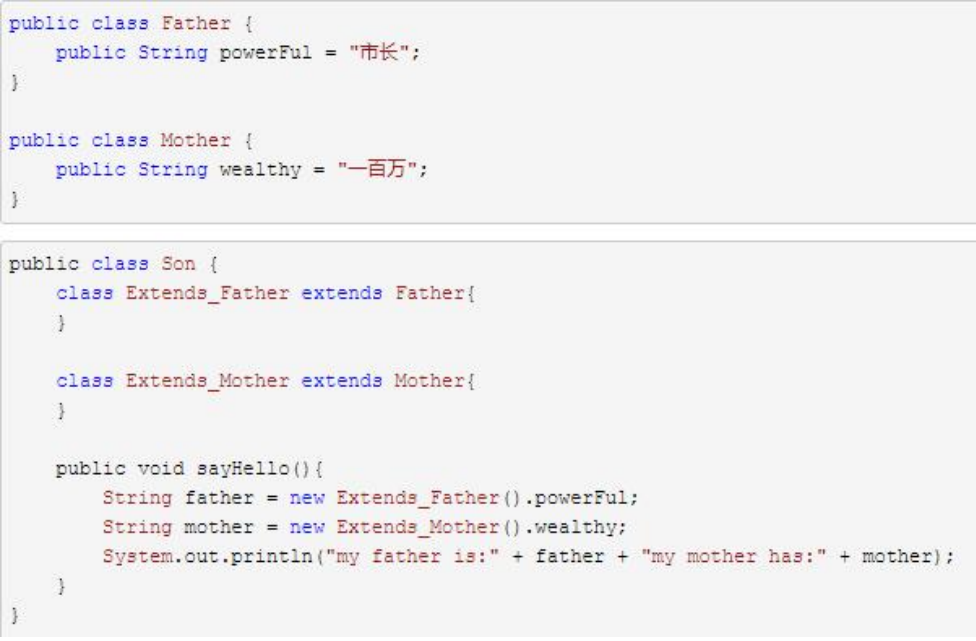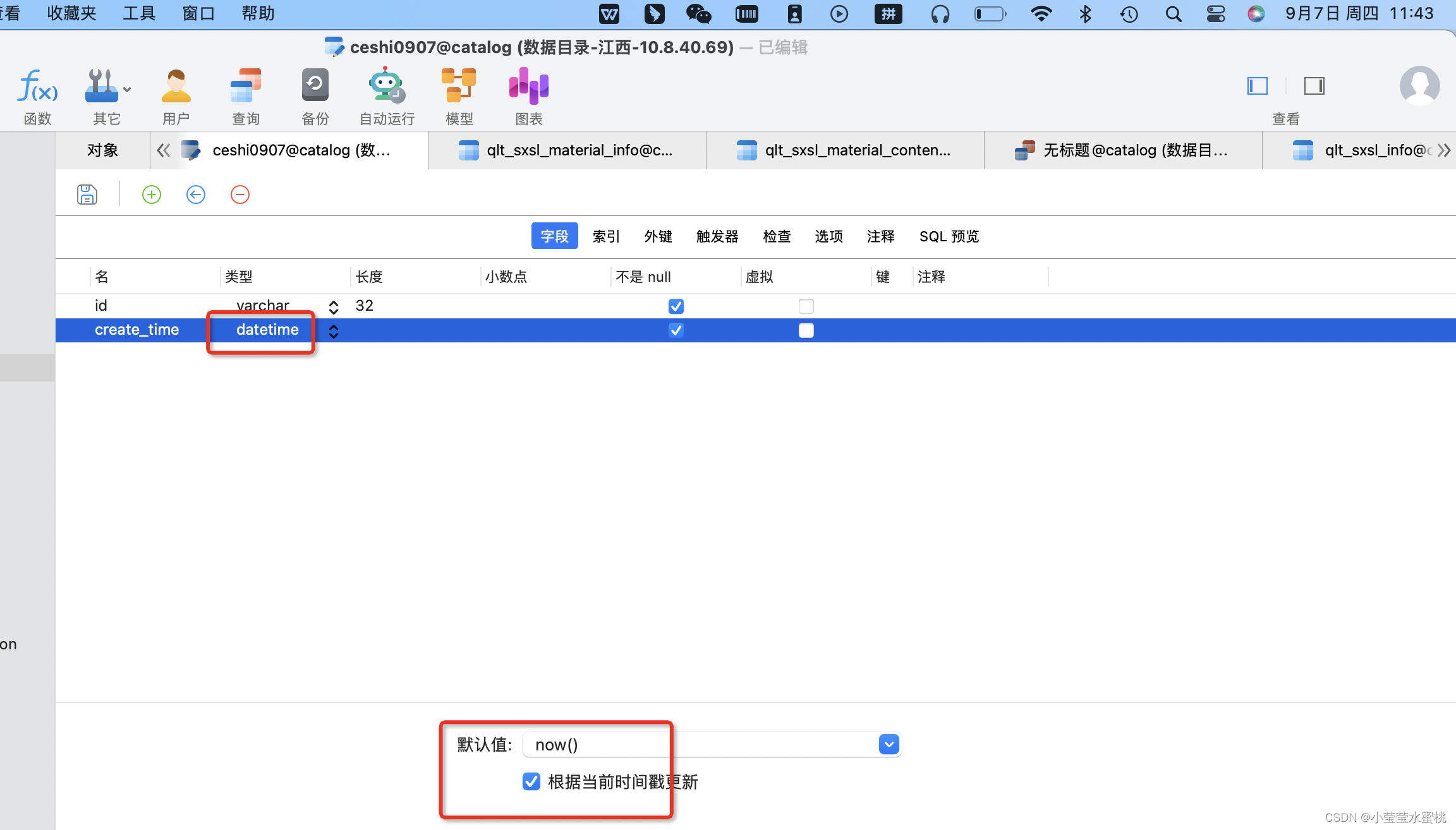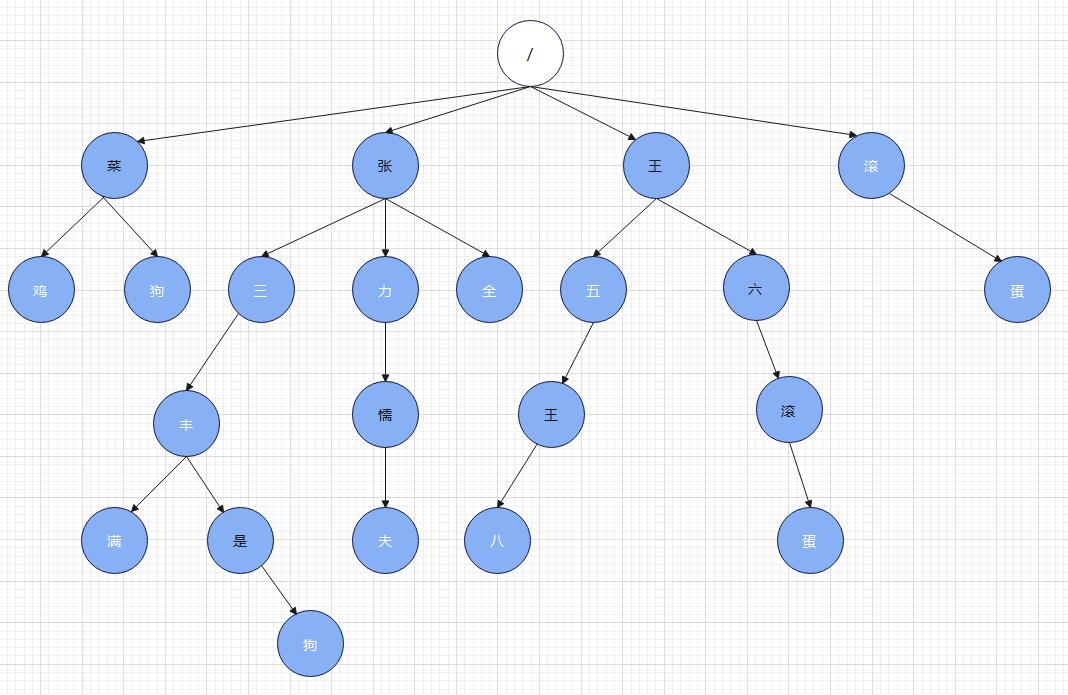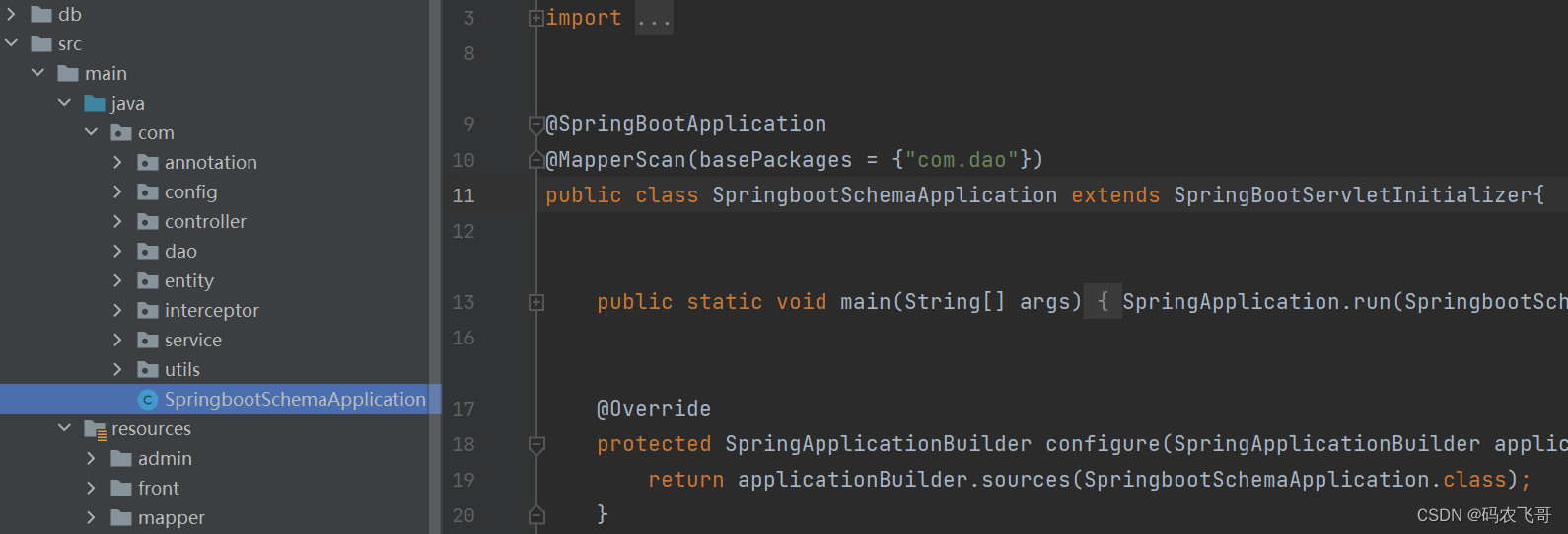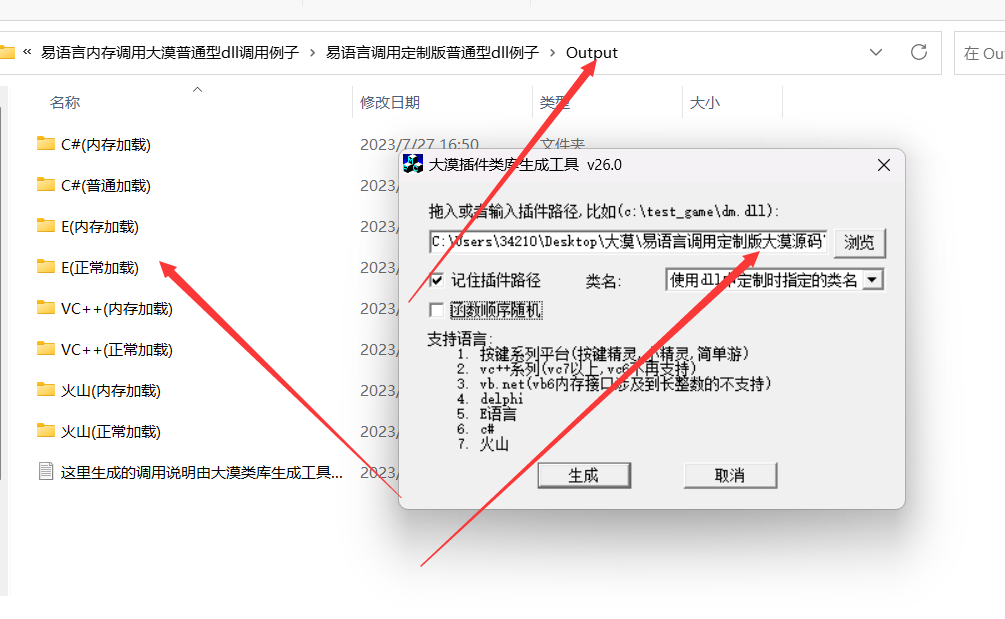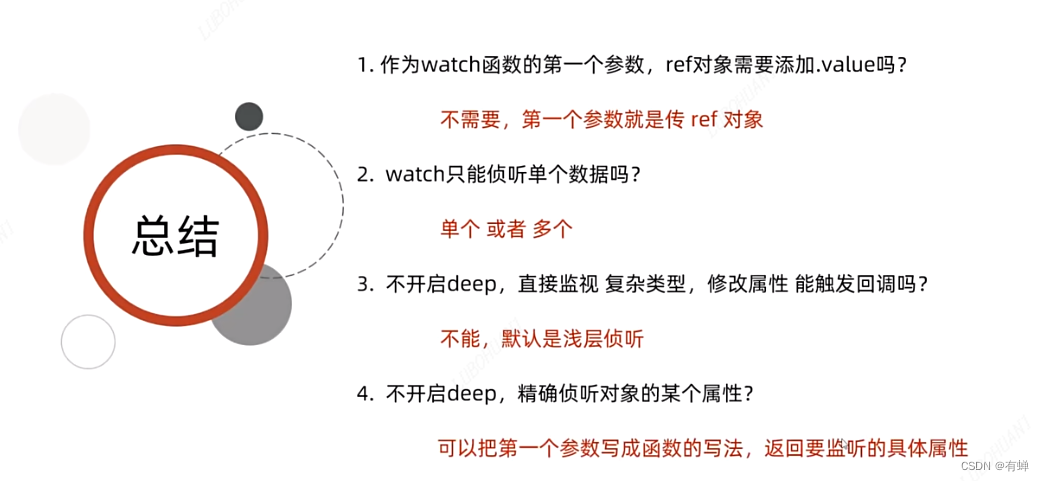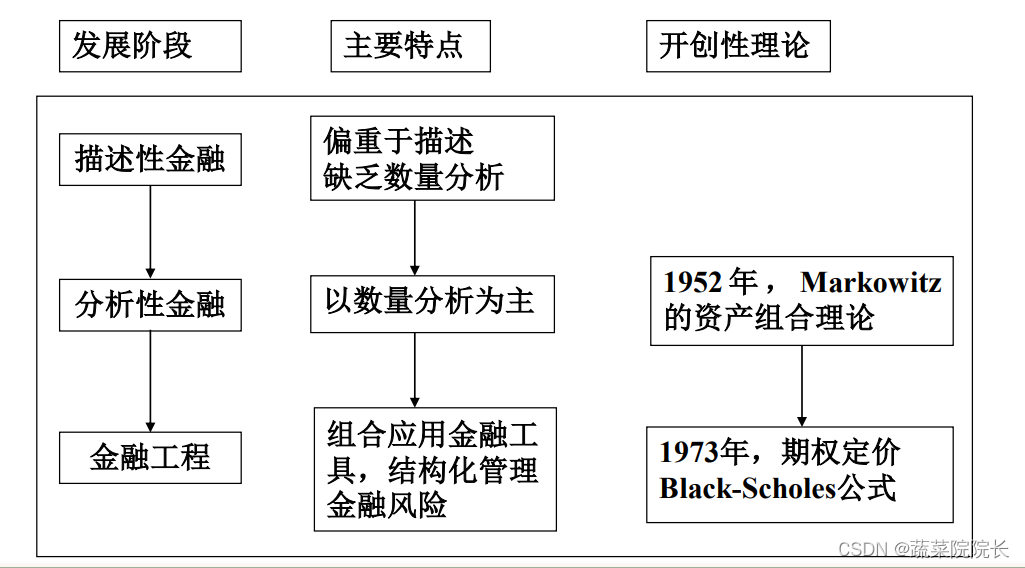1. LaTeX总结
文章目录
- 1. LaTeX总结
- 1.1. 定义作者,通讯作者,地址,宏包
- 1.1.1. Example 1
- 1.1.2. Example 2
- 1.1.3. 特殊符号——作者标注注
- 1.2. 调整字体
- 1.2.1. 数学模式下使用正体
- 1.2.2. LaTeX内使用中文
- 1.2.3. 正文文字
- 1.3. 常用符号及字母
- 1.3.1. 符号
- 1.3.1.1. 关系符号
- 1.3.1.2. 运算符号
- 1.3.1.3. 箭头
- 1.3.1.4. 特殊符号——作者标注
- 1.3.1.5. 下划线
- 1.3.2. 常用字母
- 1.3.2.1. 花体字母
- 1.3.3. 字母或数字上下增加内容
- 1.3.3.1. 字母或者数字上方符号
- 1.3.3.2. 字母或者数字上下增加内容
- 1.3.4. 求和、积分、极限
- 1.3.4.1. 求和
- 1.3.4.2. 积分
- 1.3.4.2.1. 定积分
- 1.3.4.3. 极限
- 1.3.5. 向上、向下取整
- 1.3.5.1. 向上取整
- 1.3.5.2. 向下取整
- 1.4. 公式
- 1.4.1. 更改公式Cases中每行之间的间距
- 1.4.1.1. Equation 8pt spacing
- 1.4.1.2. Equation auto spacing
- 1.4.2. 公式过长修改
- 1.4.3. 公式内空格
- 1.5. 换行与换页
- 1.5.1. 换行
- 1.5.1.1. `\par``
- 1.5.1.2. `\\``
- 1.5.2. 换页 `\newpage``
- 1.5.3. Example
- 1.6. 表格 Table
- 1.6.1. 指定表格长度和宽度
- 1.6.1.1. 指定表格的整体长度和宽度
- 1.6.1.2. 设置单元格自动换行,及居中/靠左/靠右
- 1.6.2. 表格整体改变颜色
- 1.7. 列表
- 1.7.1. 自定义`itemize`编号格式
- 1.7.1.1. 默认的`itemize`编号格式
- 1.7.1.2. 重新定义各层的符号
- 1.7.1.3. 修改特定item的符号
- 1.7.2. 自定义enumerate编号格式
- 1.7.2.1. 默认的`enumerate`编号格式
- 1.7.2.2. enumerate各级序号连续累加
- 1.7.2.3. 列表计数器的变量
- 1.8. 对齐
- 1.8.1. 右对齐
- 1.8.1.1. 正文中右对齐
- 1.8.1.2. 公式中右对齐
/*
- File: LaTeX总结.md
- Project: LaTeX软件使用总结
- File Created: Wednesday, 10th November 2021 7:29:23 pm
- Author: Hanlin Gu (hg_fine_codes@163.com)
- Last Modified: Friday, 8th September 2023 12:11:16 am
- Modified By: HG (hg_fine_codes@163.com>)
- copyright © 2021 - 2023 Hanlin Gu
*/
1.1. 定义作者,通讯作者,地址,宏包
1.1.1. Example 1
Reference
latex 定义作者,通讯作者,联系地址宏包,package,authblk
宏包使用:authblk
\documentclass[11pt,a4paper]{article}
\usepackage[T1]{fontenc}
\usepackage[utf8]{inputenc}
\usepackage{authblk}
\title{More than one Author with different Affiliations}
\author[a]{Author A}
\author[a]{Author B}
\author[a]{Author C \thanks{Corresponding author: email@mail.com}}
\author[b]{Author D}
\author[b]{Author E}
\affil[a]{Department of Computer Science, \LaTeX\ University}
\affil[b]{Department of Mechanical Engineering, \LaTeX\ University}
% 使用 \thanks 定义通讯作者
\renewcommand*{\Affilfont}{\small\it} % 修改机构名称的字体与大小
\renewcommand\Authands{ and } % 去掉 and 前的逗号
\date{} % 去掉日期
\begin{document}
\maketitle
\end{document}
效果显示:

1.1.2. Example 2
\documentclass{article}
\usepackage{hyperref}
\newcommand{\footremember}[2]{%
\footnote{#2}
\newcounter{#1}
\setcounter{#1}{\value{footnote}}%
}
\newcommand{\footrecall}[1]{%
\footnotemark[\value{#1}]%
}
\title{How to bowl properly}
\author{%
The Dude\footremember{alley}{Holly Star Lanes Bowling Alley}%
\and Walter Sobchak\footremember{trailer}{Probably in a trailer park}%
\and Jesus Quintana\footrecall{alley} \footnote{Mexico?}%
\and Uli Kunkel\footrecall{trailer} \footnote{Germany?}%
}
\date{}
\begin{document}
\maketitle
The whole example is taken from \href{http://anthony.liekens.net/index.php/LaTeX/MultipleFootnoteReferences}{Anthony Liekens}\ldots
\end{document}
效果显示:

1.1.3. 特殊符号——作者标注注
| 符号 | LaTex | 符号 | LaTex |
|---|---|---|---|
| ∗ \ast ∗ | \ast | ⋆ \star ⋆ | \star |
| † \dagger † | \dagger | ‡ \ddagger ‡ | \ddagger |
1.2. 调整字体
1.2.1. 数学模式下使用正体
知乎:LaTeX系列笔记(3)-数学运算符 Math Operator
https://zhuanlan.zhihu.com/p/137969798
(1)直接调用罗马体
\mathrm{d}
直接使用罗马体的问题是不能加上标、前后间距不好调。
(2)用mathop套mathrm,使它成为一个数学运算符(Math Operator)
\mathop{\mathrm{d}}
可以在导言区定义一个命令
\newcommand*{\dif}{\mathop{}\!\mathrm{d}}
(3)利用amsmath包的\operatorname实现(调用amsopn)
\usepackage{amsmath}
$\operatorname{arccot}$ % 不能把上下标放在符号的正上方或正下方
$\operatorname*{max}$ % 可以把上下标放在符号的正上方或正下方
\operatorname的具体实现比第 2 个办法略微复杂一些,可以处理一些特殊的情况(主要是处理函数名里面有特殊字符),还可以控制上下标能否放在正上方或正下方。大多数情况和上一个方法是是完全等效的。
(4)推荐:使用\operatorname打包成的\DeclareMathOperator
\usepackage{amsmath}
\DeclareMathOperator{\arccot}{arccot} % 不能把上下标放在符号的正上方或正下方
\DeclareMathOperator*{\Max}{max} % 可以把上下标放在符号的正上方或正下方
可以调用
\arccot^2 % 不能用\arccot\limits^2
\Max_u, \Max\limits_u % 都可以使用
如果经常使用\Max\limits_u,一个方便的方法是
\usepackage{amsmath}
\DeclareMathOperator*{\MaxTemp}{max}
\newcommand*{\Max}[1]{\MaxTemp\limits_{#1}}
\begin{document}
\Max{u} % 也就是\Max\limits_u
\end{document}
也可以用第二个或第三个方法
\newcommand*{\Max}[1]{\mathop{\mathrm{max}}\limits_{#1}}
或者是
\newcommand*{\Max}[1]{\operatorname*{max}\limits_{#1}}
\begin{document}
\Max{u}
\end{documnet}
(5)更换\Re和\Im的符号为Re和Im
\renewcommand{\Re}{\operatorname{Re}}
\renewcommand{\Im}{\operatorname{Im}}
1.2.2. LaTeX内使用中文
使用中文撰写 L a T e X LaTeX LaTeX文件需要注意以下问题:
确认TeX发行版是否支持中文,如CTeX、TeX Live、MiKTeX等;
需要在导言区中使用\usepackage{xeCJK}或\usepackage{ctex}加载中文宏包;
相关编辑器需要设置为UTF-8编码格式;
纯英文TeX文档可能会出现中文乱码问题,可以使用UTF-8编码格式或GBK编码格式。
下面是一个简单的中文示例:
\documentclass{article}
\usepackage{xeCJK} %或者使用\usepackage{ctex}
\setCJKmainfont{SimSun} %设置为系统中的宋体字体,也可以换成其他常见中文字体
\begin{document}
这是一段中文。 %请确保编辑器编码格式正确,否则会出现中文乱码
数学公式: $E=mc^2$。
\end{document}

注意:在编译时,需要使用xelatex将其编译成 PDF。
1.2.3. 正文文字
| 功能 | 显示 | L a T e X LaTeX LaTeX |
|---|---|---|
| 加粗 | 加粗字体 \textbf{加粗字体} 加粗字体 | \textbf{加粗字体} |
| 斜体 | 斜体字体 \textit{斜体字体} 斜体字体 | \textit{斜体字体} |
| 加粗并斜体 | 加粗与斜体 \textbf{\textit{加粗与斜体}} 加粗与斜体 | \textbf{\textit{加粗与斜体}} |
1.3. 常用符号及字母
List of LaTeX mathematical symbols - OeisWiki
PDF文件The Comprehensive LaTeX Symbol List (ctan.org)
1.3.1. 符号
1.3.1.1. 关系符号
| 名称 | 符号 | L a T e X LaTeX LaTeX | 名称 | 符号 | L a T e X LaTeX LaTeX |
|---|---|---|---|---|---|
| 约等于 is approximately | ≈ \approx ≈ | \approx | 近似于 is similar to | ∼ \sim ∼ | \sim |
| 正比于 is proportional to | ∝ \propto ∝ | \propto | 不等于 is not equal to | ≠ \ne = | \ne |
| 真子集 is a proper subset of | ⊂ \subset ⊂ | \subset | 子集 is a subset of | ⊆ \subseteq ⊆ | \subseteq |
| is a proper superset of | ⊃ \supset ⊃ | \supset | is a superset of | ⊇ \supseteq ⊇ | \supseteq |
| 非子集 is not a proper subset of | ⊄ \not\subset ⊂ | \not\subset | 差集 set difference | ∖ \setminus ∖ | \setminus |
| 交集 intersect | ∩ \cap ∩ | \cap | 并集 union | ∪ \cup ∪ | \cup |
| 平行 is parallel with | ∥ \parallel ∥ | \parallel | 元素 is member of | ∈ \in ∈ | \in |
1.3.1.2. 运算符号
| 名称 | 符号 | L a T e X LaTeX LaTeX | 名称 | 符号 | L a T e X LaTeX LaTeX |
|---|---|---|---|---|---|
| 加减与减加 plus or minus minus or plus |
±
\pm
± ∓ \mp ∓ | \pm \mp | 乘法 | × \times × | \times |
| 点乘 dot product | ⋅ \cdot ⋅ | \cdot | 张量乘积 tensor product | ⊗ \otimes ⊗ | \otimes |
| 除法 | ÷ \div ÷ | \div | 度数 degree | θ ∘ \theta^{\circ} θ∘ | \theta^{\circ} |
| 模 Norm | ∥ v ∥ \lVert \boldsymbol{v} \rVert ∥v∥ | \lVert \boldsymbol{v} \rVert |
1.3.1.3. 箭头
| 符号 | L a T e X LaTeX LaTeX | 符号 | L a T e X LaTeX LaTeX |
|---|---|---|---|
| → \to → | \to | → \rightarrow → | \rightarrow |
| ⇒ \Rightarrow ⇒ | \Rightarrow | ⟹ \Longrightarrow ⟹ | \Longrightarrow |
| ↔ \leftrightarrow ↔ | \leftrightarrow | ⇔ \Leftrightarrow ⇔ | \Leftrightarrow |
| ⟺ \iff ⟺ | \iff |
1.3.1.4. 特殊符号——作者标注
| 符号 | L a T e X LaTeX LaTeX | 符号 | L a T e X LaTeX LaTeX |
|---|---|---|---|
| ∗ \ast ∗ | \ast | ⋆ \star ⋆ | \star |
| † \dagger † | \dagger | ‡ \ddagger ‡ | \ddagger |
1.3.1.5. 下划线
在文章中输入单个下划线可使用: \textunderscore
输入长下划线可使用:
(1)\rule{4cm}{0.4pt} 创建一个4cm长,0.4 points厚的下划线;
\documentclass{article}
\begin{document}
This is a long underscore: \rule{4cm}{0.4pt}
\end{document}
(2)使用ulem宏包中的\uline{\hspace{4cm}} 创建了一个4cm长的下划线。
\documentclass{article}
\usepackage{ulem}
\begin{document}
This is a long underscore: \uline{\hspace{4cm}}
\end{document}
1.3.2. 常用字母
常用字母列表:
| 符号 | L a T e X LaTeX LaTeX | 符号 | L a T e X LaTeX LaTeX |
|---|---|---|---|
| φ \varphi φ | \varphi | ϕ \phi ϕ | \phi |
| σ \sigma σ | \sigma | τ \tau τ | \tau |
| ξ \xi ξ | \xi | ϵ \epsilon ϵ | \epsilon |
| ρ \rho ρ | \rho | η \eta η | \eta |
| α \alpha α | \alpha | β \beta β | \beta |
| γ \gamma γ | \gamma | θ \theta θ | \theta |
1.3.2.1. 花体字母
参考:latex如何输出花体字母
https://blog.csdn.net/weixin_43748786/article/details/100851307
引用包:
\usepackage{amsmath, amsthm, amssymb}
\usepackage{mathrsfs}
命令语句:
$\mathbb{R}$
$\mathcal{R}$
$\mathscr{R}$
显示效果:
| 符号 | L a T e X LaTeX LaTeX | 符号 | L a T e X LaTeX LaTeX | 符号 | L a T e X LaTeX LaTeX |
|---|---|---|---|---|---|
| R \mathbb{R} R | \mathbb{R} | R \mathcal{R} R | \mathcal{R} | R \mathscr{R} R | \mathscr{R} |
1.3.3. 字母或数字上下增加内容
1.3.3.1. 字母或者数字上方符号
| 符号 | L a T e X LaTeX LaTeX | 符号 | L a T e X LaTeX LaTeX | 符号 | L a T e X LaTeX LaTeX |
|---|---|---|---|---|---|
| a ^ \hat{a} a^ | \hat{a} | a ^ \widehat{a} a | \widehat{a} | a ˇ \check{a} aˇ | \check{a} |
| a ~ \tilde{a} a~ | \tilde{a} | a ~ \widetilde{a} a | \widetilde{a} | ||
| a ˙ \dot{a} a˙ | \dot{a} | a ¨ \ddot{a} a¨ | \ddot{a} | ||
| a ˉ \bar{a} aˉ | \bar{a} | a ‾ \overline{a} a | \overline{a} | a ⃗ \vec{a} a | \vec{a} |
| a ˊ \acute{a} aˊ | \acute{a} | a ˋ \grave{a} aˋ | \grave{a} | a ˘ \breve{a} a˘ | \breve{a} |
1.3.3.2. 字母或者数字上下增加内容
使用\substack{},在字母
σ
\sigma
σ下方加点,\\ 后方为字母下方的符号
| 符号 | LaTex |
|---|---|
| σ ˙ \substack{\sigma \\\\{\dot{}}} σ˙ | \substack{\sigma \\{\dot{}}} |

1.3.4. 求和、积分、极限
1.3.4.1. 求和
| 符号 | LaTex | 符号 | LaTex |
|---|---|---|---|
| ∑ i = 1 N \sum_{i=1}^{N} ∑i=1N | \sum_{i=1}^{N} | ∑ i = 1 N \sum\limits_{i=1}^{N} i=1∑N | \sum\limits_{i=1}^{N} |
1.3.4.2. 积分
| 符号 | LaTex | 符号 | LaTex |
|---|---|---|---|
| ∫ \int ∫ | \int | ∫ 1 2 x d x \int_1^{2} x \mathrm{d} x ∫12xdx | \int_1^{2} x \mathrm{d} x |
| ∫ 1 10 \int_{1}^{10} ∫110 | \int_{1}^{10} | ∫ 1 10 \int\limits_{1}^{10} 1∫10 | \int\limits_{1}^{10} |
1.3.4.2.1. 定积分
∣
∣
a
0
a
\left.\vphantom{\Big|}\right|_{a_0}^{a}
a0a: \left.\vaphantom{\Big|}\right|_{a_0}^{a}
- 示例1
∫ a 0 a x d x = 1 2 x 2 ∣ ∣ a 0 a = 1 2 ( a 2 − a 0 2 ) \int \limits_{a_0}^{a}x \mathrm{d}x=\dfrac{1}{2}x^2 \left.\vphantom{\Big|}\right|_{a_0}^{a}=\dfrac{1}{2}(a^2-{a_0}^2) a0∫axdx=21x2 a0a=21(a2−a02)
\int \limits_{a_0}^{a}x \mathrm{d}x
=\dfrac{1}{2}x^2 \left.\vphantom{\Big|}\right|_{a_0}^{a}
=\dfrac{1}{2}(a^2-{a_0}^2)
- 示例2
∫ a 0 a x d x = 1 2 x 2 ∣ ∣ a 0 a = 1 2 ( a 2 − a 0 2 ) \begin{aligned} \int \limits_{a_0}^{a} x \mathrm{d}x &= \dfrac{1}{2} x^2 \left.\vphantom{\Big|}\right|_{a_0}^{a}\\\\ &= \dfrac{1}{2}(a^2 - a_0^2) \end{aligned} a0∫axdx=21x2 a0a=21(a2−a02)
\begin{aligned}
\int \limits_{a_0}^{a} x \mathrm{d}x
&= \dfrac{1}{2} x^2 \left.\vphantom{\Big|}\right|_{a_0}^{a}\\
&= \dfrac{1}{2}(a^2 - a_0^2)
\end{aligned}
1.3.4.3. 极限
| 符号 | LaTex | 符号 | LaTex |
|---|---|---|---|
| lim n → ∞ \lim_{n \to \infty} limn→∞ | \lim_{n \to \infty} | lim n → ∞ \lim\limits_{n \to \infty} n→∞lim | \lim\limits_{n \to \infty} |
上、下极限
| 符号 | LaTex | 符号 | LaTex |
|---|---|---|---|
| l i m ‾ n → ∞ \varlimsup_{n \to \infty} limn→∞ | \varlimsup_{n \to \infty} | l i m ‾ n → ∞ \varliminf_{n \to \infty} limn→∞ | \varliminf_{n \to \infty} |
1.3.5. 向上、向下取整
1.3.5.1. 向上取整
⌈
a
⌉
\lceil a \rceil
⌈a⌉: \lceil a \rceil
⌈ 3.14 ⌉ = 4 \lceil 3.14 \rceil = 4 ⌈3.14⌉=4
1.3.5.2. 向下取整
⌊
a
⌋
\lfloor a \rfloor
⌊a⌋: \lfloor a \rfloor
⌊ 3.14 ⌋ = 3 \lfloor 3.14 \rfloor = 3 ⌊3.14⌋=3
1.4. 公式
1.4.1. 更改公式Cases中每行之间的间距
1.4.1.1. Equation 8pt spacing
在首行\\后,增加需要添加的行距大小,如下 [8pt]
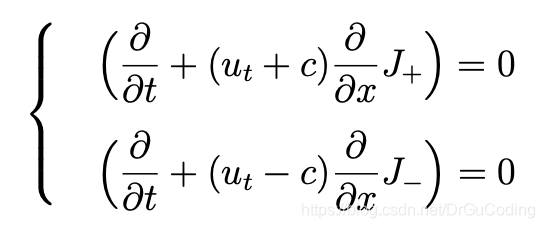
\begin{equation}
\begin{cases}
& \Big( \dfrac{\partial}{\partial t} + (u_t + c) \dfrac{\partial}{\partial x} J_{+} \Big) = 0\\[8pt]
& \Big( \dfrac{\partial}{\partial t} + (u_t - c) \dfrac{\partial}{\partial x} J_{-} \Big) = 0
\end{cases}
\end{equation}
1.4.1.2. Equation auto spacing
若\\后无[8pt],则效果为

\begin{equation}
\begin{cases}
& \Big( \dfrac{\partial}{\partial t} + (u_t + c) \dfrac{\partial}{\partial x} J_{+} \Big) = 0\\
& \Big( \dfrac{\partial}{\partial t} + (u_t - c) \dfrac{\partial}{\partial x} J_{-} \Big) = 0
\end{cases}
\end{equation}
1.4.2. 公式过长修改
Reference
(更新中)记录 LaTeX 遇到过的问题
\documentclass{article}
\usepackage{graphicx}
\begin{document}
\begin{equation}
\resizebox{.9\hsize}{!}{$A+B+C+D+E+F+G+H+I+J+K+L+M+N+O+P+Q+R+S+T+U+V+W+X+Y+Z$}
\end{equation}
\end{document}
1.4.3. 公式内空格
\quad生一个宽度为1em的空格;\qquad产生一个宽度为2em的空格;\,产生一个窄空格,通常用于数字与单位之间的间隔;\:产生一个比\,宽一点的窄空格;\;产生一个比\:宽一点的窄空格;\!产生一个负的窄空格,通常用于消除紧贴其后的字符之间不必要的间隔。
\documentclass{article}
\usepackage{amsmath}
\begin{document}
公式内的空格: \\
$\int_{0}^{1} x\,dx$ \\
$\sqrt{a}\qquad \sqrt{a+\frac{b}{c}}\qquad \sqrt[n]{1+x+x^2+\dots+x^n}$ \\
$\sum_{i=1}^{n} a_i$ \\
$a\!+\!b$ \\
$f(x)\!=\!\alpha\!+\!\beta x\!+\!\gamma x^2$
\end{document}

1.5. 换行与换页
LaTeX默认是不换行的,并且默认内容超过一页的话就自动换页。但是有时候我们需要强制换行或强制换页操作,这个时候就需要用到LaTeX的换行换页命令了。这里介绍如何在LaTeX里面进行强制换行,换页操作。
1.5.1. 换行
1.5.1.1. `\par``
\par命令用在需要换行的内容前面,将之后的内容进行换行操作.
1.5.1.2. `\``
\\用在每一行的末尾,之后的内容便会出现在新的一行。
1.5.2. 换页 `\newpage``
\newpage之后为下一页内容。
1.5.3. Example
\documentclass{letter}
\begin{document}
This is the first line.
\par{This is the second line.}\\
This is the 3rd line.
\newpage
New page.
\end{document}
显示结果:


1.6. 表格 Table
1.6.1. 指定表格长度和宽度
Reference
【latex技巧】设置表格的长度宽度,单元格指定宽度,自动换行,对齐
1.6.1.1. 指定表格的整体长度和宽度
在\begin{tabular}前使用\resizebox{0.8\textwidth}{20cm}{},即可自动缩放表格,其中\textwidth是正文宽度。第一个参数是表格宽度,第二个参数是表格长度,第三个参数是tabular表格。
使用resizeboxcommand需要添加宏包\usepackage{graphicx}
Example:
\resizebox{0.8\textwidth}{!}{
\begin{tabular}
\end{tabular}
}

\documentclass{article}
\usepackage{graphicx}
\begin{document}
\begin{table}[!h]
\resizebox{0.9\textwidth}{!}{
\begin{tabular}{l | c | r}
\hline
Column 1 & Column 2 & Column 3\\
\hline
1-1 & 2-1 & 3-1\\
\hline
1-2 & 2-2 & 3-2\\
\hline
\end{tabular}
}
\end{table}
\end{document}
1.6.1.2. 设置单元格自动换行,及居中/靠左/靠右
\usepackage{tabularx}调用tabularx宏包,来使用tabular。
设置单元格格式时使用诸如m{2cm<{\raggedright},即可指定单元格内容左对齐、宽度2cm、自动换行。
参数含义:m 垂直居中,b 垂直靠上,p 垂直靠下。
2cm是单元格宽度。
\raggedright 靠左,\centering 居中,\raggedleft 靠右。

\documentclass{article}
\usepackage{tabularx} % adjust the width of tabular table
\begin{document}
\begin{tabular}{m{0.1\textwidth}<{\raggedright} | b{0.8\textwidth}<{\centering} | p{0.1\textwidth}<{\raggedleft}}
\hline
Column 1 & Column 2 & Column 3\\
\hline
column one is what & {column two\newline can change new line\newline and be centered top aligned} & right bottom aligned\\
\hline
\end{tabular}
\end{document}
注意:\multirow的单元格自动换行需要使用 \multirow{10}{3cm}{内容}
第一个参数是对多少行进行合并,第二个参数是该单元格宽度,超过则会自动换行,\multirow{10}{*}表示不自动换行。
1.6.2. 表格整体改变颜色
在\begin{tabular}之前使用\textcolor{red}{表格内容}

\documentclass{article}
\usepackage{tabularx} % change the width and text alignment of the "tabular" table
\usepackage{color} % use "\textcolor"
\begin{document}
\textcolor{red}{
\begin{tabular}{m{0.1\textwidth}<{\raggedright} | b{0.8\textwidth}<{\centering} | p{0.1\textwidth}<{\raggedleft}}
\hline
Column 1 & Column 2 & Column 3\\
\hline
column one is what & {column two\newline can change new line\newline and be centered top aligned} & right bottom aligned\\
\hline
\end{tabular}
}
\end{document}
1.7. 列表
Reference
LaTex 列表
列表可以通过\itemize{}, \list{}, \enumerate{}, \description{}环境进行表达。
1.7.1. 自定义itemize编号格式
Reference
Latex自定义itemize的编号格式
1.7.1.1. 默认的itemize编号格式
Level 1 是 \textbullet (•)
Level 2 是 \textendash (–)
Level 3 是 \textasteriskcentered (*)
Level 4 是 \textperiodcentered (·).

\begin{itemize}
\item First Level
\begin{itemize}
\item Second Level
\begin{itemize}
\item Third Level
\begin{itemize}
\item Fourth Level
\end{itemize}
\end{itemize}
\end{itemize}
\end{itemize}
1.7.1.2. 重新定义各层的符号
可以把renewcommand命令加在preamble导言区,这样可以实现全局修改。(推荐使用)
这些符号可以通过renewcommand{}{}命令重新定义,第一个参数是要定义的层级,第二个参数是新定义的符号样式。
在preamble中,即在\documentclass{}和\begin{document}之间,添加新的符号定义。
%%%%%%%%%%%%%%%%%%%%%%%%%%%%%%%%%%%%
% put 'renewcommand' in the preamble
%%%%%%%%%%%%%%%%%%%%%%%%%%%%%%%%%%%%
\renewcommand{\labelitemi}{+} % renew the 1st level of itemize into "+" symbol
\renewcommand{\labelitemii}{-} % renew the 2nd level of itemize into "-" symbol
\renewcommand{\labelitemiii}{*} % renew the 3rd level of itemize into "*" symbol
\renewcommand{\labelitemiv}{\textbullet} % renew the 4th level of itemize into "\textbullet" symbol
注意那个labelitemi,你想改第几个level的符号,你就改那个i
labelitemi 对于 Level 1
labelitemii 对于 Level 2
labelitemiii 对于 Level 3
labelitemiv 对于 Level 4

\begin{itemize}
\item First Level
\begin{itemize}
\item Second Level
\begin{itemize}
\item Third Level
\begin{itemize}
\item Fourth Level
\end{itemize}
\end{itemize}
\end{itemize}
\end{itemize}
1.7.1.3. 修改特定item的符号
\begin{itemize}
\item Default item label for entry one
\item Default item label for entry two
\item[+] Custom item label for entry three
\end{itemize}
1.7.2. 自定义enumerate编号格式
Reference
LaTex 列表
\renewcommand可以通过使用重新定义标签生成命令来配置
LaTeX
\LaTeX
LATEX的标准标签,并且对于enumerate环境,您还可以使用适当的计数器变量。
1.7.2.1. 默认的enumerate编号格式

\documentclass{article}
\begin{document}
\begin{enumerate}
\item First level item
\item First level item
\begin{enumerate}
\item Second level item
\item Second level item
\begin{enumerate}
\item Third level item
\item Third level item
\begin{enumerate}
\item Fourth level item
\item Fourth level item
\end{enumerate}
\end{enumerate}
\end{enumerate}
\end{enumerate}
\end{document}
1.7.2.2. enumerate各级序号连续累加

\documentclass{article}
\renewcommand{\labelenumii}{\arabic{enumi}.\arabic{enumii}} % enumerate 2nd level with previous item number
\renewcommand{\labelenumiii}{\arabic{enumi}.\arabic{enumii}.\arabic{enumiii}} % enumerate 3rd level with previous item number
\renewcommand{\labelenumiv}{\arabic{enumi}.\arabic{enumii}.\arabic{enumiii}.\arabic{enumiv}}
\begin{document}
\begin{enumerate}
\item One
\item Two
\item Three
\begin{enumerate}
\item Three point one
\begin{enumerate}
\item Three point one, point one
\begin{enumerate}
\item Three point one, point one, point one
\item Three point one, point one, point two
\end{enumerate}
\end{enumerate}
\end{enumerate}
\item Four
\item Five
\end{enumerate}
\end{document}
1.7.2.3. 列表计数器的变量
在前面的示例中,该命令\arabic用于排版各种标签计数器变量的当前值。请注意,“阿拉伯数字”和命令的使用\arabic是指数字0到9.
通常,可以使用以下 5 个命令之一以各种格式打印 计数器变量:
\arabic{counter variable}
\roman{counter variable}
\Roman{counter variable}
\Alph{counter variable}
\alph{counter variable}
Example:

\documentclass{article}
\begin{document}
\begin{verbatim}
\newcounter{foo}
\setcounter{foo}{2}
\end{verbatim}
\newcounter{foo}
\setcounter{foo}{2}
\begin{itemize}
\item \verb|\arabic{foo}| produces \arabic{foo}
\item \verb|\roman{foo}| produces \roman{foo}
\item \verb|\Roman{foo}| produces \Roman{foo}
\item \verb|\Alph{foo}| produces \Alph{foo}
\item \verb|\alph{foo}| produces \alph{foo}
\end{itemize}
\end{document}
1.8. 对齐
1.8.1. 右对齐
实现从一个位置开始,将后面部分右对齐
1.8.1.1. 正文中右对齐
(1)通过添加\hfill,可参考一下示例
\documentclass{article}
\begin{document}
Some text \hfill This text is right-aligned.
\end{document}
(2)如果要实现一段文字右对齐,可使用flushright环境,如下
\documentclass{article}
\begin{document}
\begin{flushright}
This text is right-aligned.
\end{flushright}
\end{document}
效果显示:

1.8.1.2. 公式中右对齐
在LaTeX中,公式默认是居中对齐的,而无法直接在公式中的某个位置将内容右对齐到页面最右端。不过,可以通过一些其他的方法来实现这个效果。
一种常用的方法是使用\hfill命令配合\tag*{}命令,将某个位置之后的内容右对齐到页面最右端,并将其标记为一个自定义的标签。以下是一个示例:
\documentclass{article}
\usepackage{amsmath}
\begin{document}
\begin{align*}
a &= b + c \\
d &= e + f + g \tag*{\hfill$(\text{Right-aligned text})$}
\end{align*}
\end{document}
在上述示例中,我们使用\tag*{}命令将\hfill$(\text{右对齐的内容})$作为标签添加到第二行的末尾。\tag*{}命令的作用是在不打印编号的情况下添加一个自定义的标签。结合\hfill命令,标签将会右对齐到页面最右端。
效果显示:

其中,\tag*{}内是文本格式,所以如果需要输出公式则需要添加$$符号;如果只有文字,则可以直接输入文字,或者使用$\text{}$。

